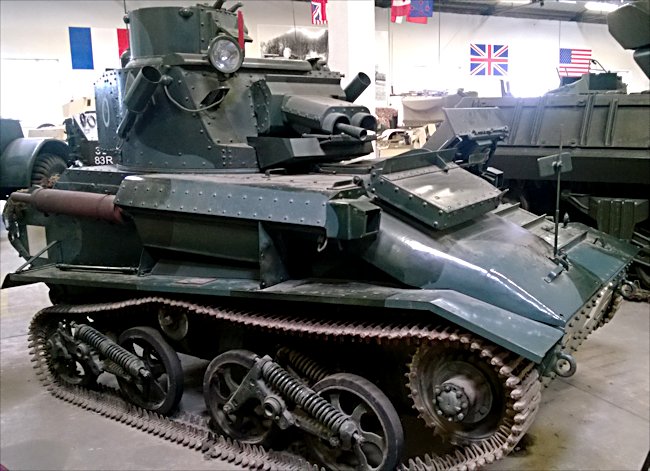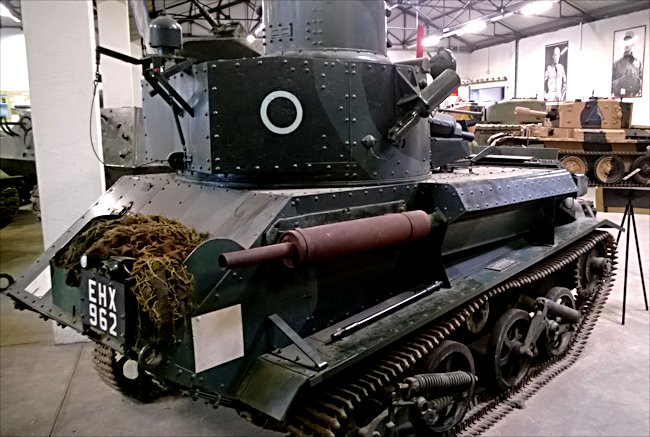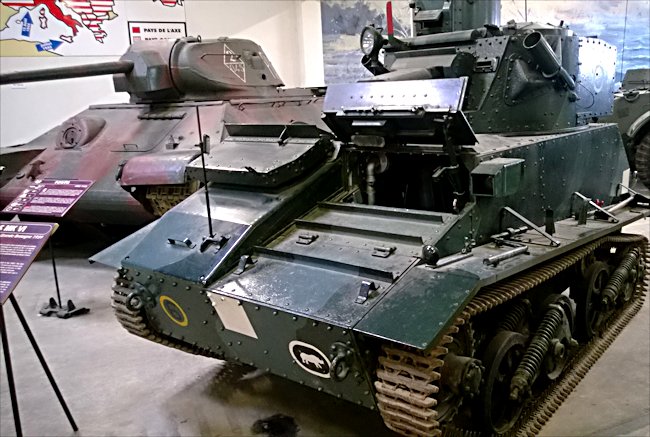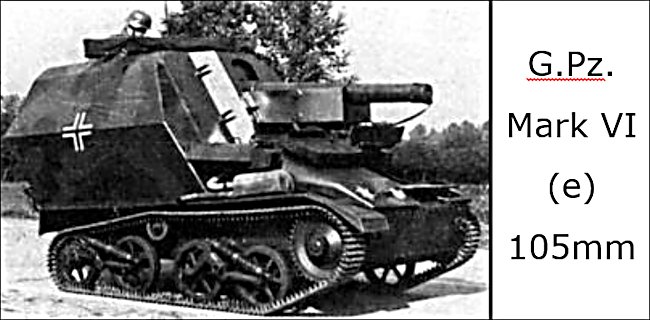The Vickers Mk VI Light Tank
This British Vickers Light Tank MkVI can be found at the French Tank Museum in Saumur in the Loire Valley. The Museum is called Musée des Blindés ou Association des Amis du Musée des Blindés, 1043, route de Fontevraud, 49400 Saumur, France www.museedesblindes.fr . The word Blindés means armoured.

Vickers MkVI Light Tank at the French Tank Museum in Saumur, France
The Vickers Light Tank MkVI origins go back to a series of small tanks built in the 1920's. This tank possessed riveted armour of only 14mm thick. It could only just stop a rifle bullet. The turret was manned by two crew members, the Commander and Gunner/radio operator, whilst the Driver sat in the front of the hull in the middle. The tall cupola gave the tank a high profile that could easily be seen by the enemy. The only good thing about this vehicle was that it had a top speed of 56 km/h 35mph.
British tank crew member Bert Rendell was stationed with his regiment in Wiltshire. They were issued with 56 new Vickers Mark six light tanks in 1936. He was not impressed with the design of the tank. It had a three man crew but he complained that the gunner/radio operator position was useless. That crew member could not operate the radio, load and fire the gun at the same time. On the battlefield you can see the problem. Crews were frustrated at poor design. When you tanks were produced, it appeared like there was no advancement. British tank crews felt really let down, especially as in 1937 the British Army was being prepared for war.

Vickers Light Tank MkVI Tank rear view. It was one of the first British tanks to be fitted with smoke dischargers.
When the Second World War began in September 1939 the British Army had 1,002 Vickers Mark VI light tanks in operational service. They only had 392, other tanks. This thinly armoured machine gun only, light reconnaissance tank, made up the bulk of the British Army's tank strength. Its German equivalent was the Panzer I tank. In theory the heavy cal.50 (12.7 mm) Vickers had some armor piercing capabilities against armored cars and other light tanks. It could go through 16 mm (0.63 in) of armour which meant that it could damage a Panzer I tank if it was close enough, but not any of the later manufactured Panzer II tanks Ausf D onwards.
When British expeditionary Force landed in France in 1940. Most of the armoured divisions were partly equipped with this tank. That includes the seven Royal Armoured Corps Divisional Cavalry Regiment the 3rd Royal Tank Regiment and the 1st Armoured Division. It was outclassed. It could not win a fight with a German Panzer II or Panzer III. It was no match for the German 88 mm anti-tank gun. All of the Vickers Mark VI light tanks sent over to France were left there when the British Army retreated back to England at Dunkirk.

Vickers Light Tank Mk VI Tank with driver's hatch open. Notice the driver's position is on the left side of the tank.
Vickers Mark VI light tanks were also sent to North Africa in 1939. The main tank engagements were left to the bigger Cruiser and Matilda tanks. They would sometimes join in with the more powerful tanks, but more often were used for flanking maneuvers against the Italian troops. They suffered heavy losses. They were eventually replaced by the American M3 Stuart Tank. The second Royal Tank Regiment were still using these light tanks to fight the Italians as late as 6th February 1941. They also saw operational service in the battle of Greece, and the battle of Crete.
5th Royal Tank Regiment (the filthy fifth) 5 RTR memories
Cherbourg, Northern France, June 1940 men from the 5th tanks are stuck on the port side waiting for a ship home. They have been blooded in the disastrous battle of France. Their unit was scattered. They were disillusioned and bitter. They had only arrived a few weeks earlier.
They had been given orders to support the British expeditionary Force help stop the German invasion of France and Belgium. But as they approached the River Somme in their Vickers Mark VI light tanks, that were fast, poorly armoured and already obsolete, they received a very bloody nose from superior German panzers.
By 1940 the tank was the essential weapon of the battlefield, yet Britain simply did not have what was needed. They have left it too late to start their rearmament and the people paid with the tank crews of units like the 5th Royal Tanks. Pursued by the German tank divisions. They went to pieces claiming they never got any orders let alone ammunition, food or fuel. Along with their retreating French allies, most of their equipment was abandoned. It was a shambles on a grand scale.
During those few weeks in France they could only claim one German knocked out Panzer and lost all their Vickers Mark VI light tanks. The tank crews first experience of war had been an exercise in humiliation.
Tank Commander Corporal Harry Finlayson was 25 in 1940. He was a regular and had already seen service in India. He recalls, "When I first went in I thought, 'oh good this is going to be great fun and all that,' but I realised it wasn't. There was one of our tanks near me that was blown to bits. A couple of my mates were in that. It was terrible."
A Glaswegian tank crew member, Jake Wardrop wrote a diary, against regulations, in 1940 about his experiences in France."It was all inadequate, as if you were tying down a mad ball with cotton. We had a ridiculous amount of material and an even more ridiculous amount of organisation. My own opinion of the River Somme episode was that it was a very silly place to be."

German G.Pz Mk VI (e) 105mm SPG based on a captured 1940 Vickers Light Tank Mk VI Tank chassis. Only 20 were adapted. All were destroyed in France 1944.
Where can I find other preserved Vickers Mk VI Light Tanks?
- Imperial War Museum Duxford, England
- Royal Australian Armoured Corps Memorial and Army Tank Museum - Puckapunyal, Victoria, Australia
- Military Museum, Canadian Forces Base Borden, Ontario, Canada
- Canadian Forces Base, Borden, Canada)
- Musee des Blindes, Saumur, France
- El-Alamein War Museum, Egypt
- Ministry of Defence, Cairo, Egypt
- Etimesgut Tank Müzesi, Ankara, Turkey
- Yad la-Shiryon Museum, Latrun, Israel
- former Iraqi army base, Taji, Iraq
- The Collings Foundation, Stow, MA, USA
- Fort Lee U.S. Army Ordnance Museum, VA, USA
- Military Vehicle Technology Foundation (Littlefield Collection) in Portola Valley, California, USA
- Royal Australian Armoured Corps Tank Museum Puckapunyal, VIC, Australia
- Source - Pierre-Oliver Buan - http://the.shadock.free.fr/Surviving_Panzers.html
World War Two Books

